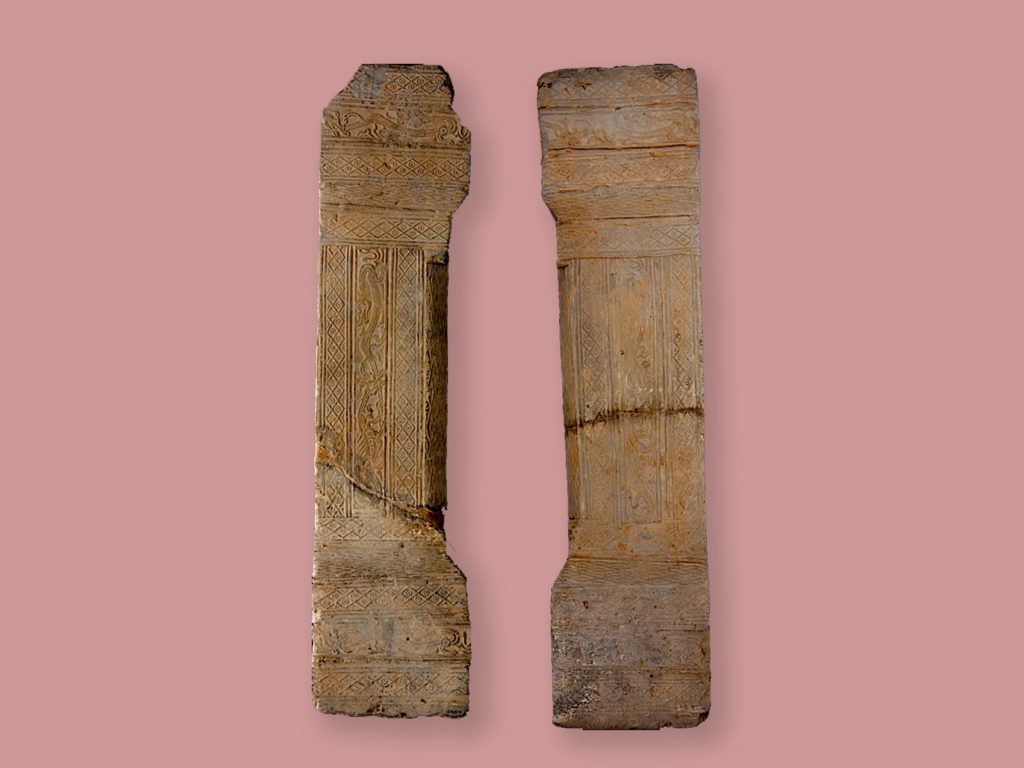
What can a pair of tomb pillars tell us about notions of time and space so contrary to our own beliefs about reality? And how might we begin to approach such visual artefacts that were made to be buried almost immediately and withdrawn from view, and intended to have been concealed for eternity?
These earthenware tomb pillars can be dated to the Western Han period, which saw significant changes to the structure of politics, belief systems, historiographic practices and artistic production in imperial China. Richly embossed with low-relief patterns on three exposed surfaces, the standing pillars placed together as a pair delineated space within a system of grave-chambers. They would have likely presided over other kinds of tomb pottery (mingqi or 明器) within the same space: court entertainers, servants, agricultural equipment, and ceremonial vessels were all commonly found in Han tombs.1 Architectural objects such as these pillars, however, are often left out or glossed over in discussions about the art of the Han period.2 The sections that follow will highlight questions of ornament and materiality, as well as an examination of the spatial organization of Han tombs, to demonstrate the importance of such objects in the study of Han funerary art as well as the context of contemporaneous beliefs about the spaces of the living and the dead.
Ornament and Meaning
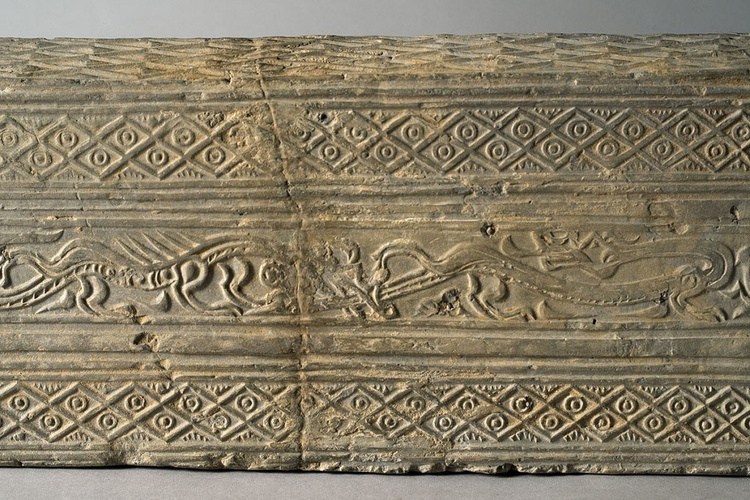
Bands of alternating friezes, both geometrical as well as representational in their design, encircle each base and capital. We can discern three different motifs shared by both pillars: two different diamond lozenge patterns in a regular geometrical arrangement, together with a motif of intertwining dragon-like creatures scrolling around both the base and the capital, fill every visible surface (see images above). These patterns also repeat along the length of each column, which is four-sided with bevels on the inward-facing corners.
Geometric patterns with little connection to the natural world are largely thought to have originated in textiles and weaving. Here, they consist of diamond lozenges enclosing a circular motif not unlike the modern-day bullseye, while a secondary frieze, used exclusively on narrower planes that constitute the bevels, features a foreshortening of the vertical axis and an elongation of the horizontal axis of the main pattern. The arrangement of primary and secondary patterns results in a fairly sophisticated tromp l’oeil deepening of the planes that are in recession, resulting in more pronounced bevel effects at the corners and edges of both pillars, and exaggerates the proportions of the structure. This is all crucial to the spatial schema of the tomb chamber: they seem to stretch proportions and scale to capitalize on an effect of monumentality.
The repeated motif of dragons enlivens the ornamental scheme with the introduction of a representational visual language as amusing as it is symbolic. Each unit of the motif consists of two dragons: the first is depicted biting the tail of the other, provoking some mild retaliation. Their serpentine bodies are dominated by S-shaped curves that are suggestive of dynamism and mutability; they stand in stark contrast to the rectilinear diagonals around them. It is hard to say on a first glance whether aggression or playfulness is implied here, although an iconographic gloss of the same dragon motif from Henan Province by Li Guoxing parses the scene as a lighthearted and harmonious depiction of two dragons at play [“两条龙似乎在戏耍,画面气氛宽松和谐,充满温情”].3

As to the meaning of dragon imagery similar to this, some art historians have suggested that these motifs served a protective function and were therefore usually found at tomb entrances.4 In the context of Han burial practices and the spatial expression of the afterlife in the construction of chamber tombs, which I discuss later, it is highly probable that the zoomorphic motifs of fantastic beasts such as dragons and phoenixes are not only auspicious symbols but indications that the space of the tomb is markedly unlikethe natural world above and outside it, yet bears some connection through their spatial configuration.
A closer examination of the dragon motif reveals certain details that might enrich an iconographic reading. The two dragons are rendered distinct from each other through markings on their bodies: the dragon on the left has thicker bands on its body as well as spine-like protrusions running down its back, while the dragon on the right has finer scale-like detailing to suggest smoothness. Without overstating the difference between the two dragons, it can be observed that these slight variations attest to the eclectic and heterodox ways in which artists and craftsmen imagined and depicted the mythical creature, which is even then differentiated by dragons with affinities to water, earth, air, fire, and so on. Moreover, where the first dragon has lurched forward to nip at the tail of the second dragon, a round object seems to hover beneath its neck. It is unclear if what is being represented here is the sun, a pearl, or even a bi—round objects which have all been associated with dragon iconography5—but what seems more certain is that tomb reliefs, even of seemingly plain or simple designs, constantly referred to specific texts or myths that were not only in circulation at the time, but were constantly reiterated and re-narrated within the public sphere through the material practice of tomb relief-making.
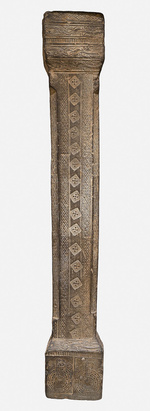
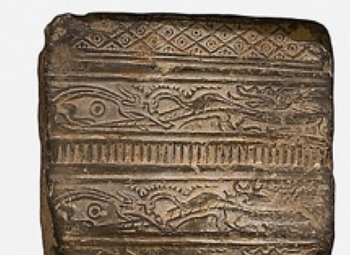
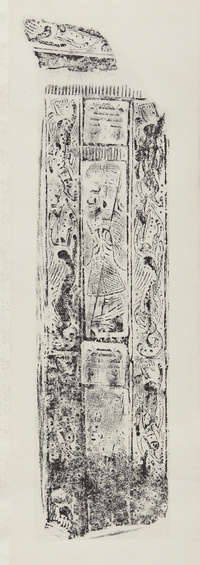
Materialities of earthenware and stone
It is probable that craftsmen working on the tomb used forming tools to create the basic shape and structure of the pillars in clay, thereby ensuring regularity in size and proportion. Evidence also points to the use of pre-carved molds to stamp impressions into the wet material before sending the pieces to a kiln for firing.

This method of relief-making is revealed most strikingly in parts where reliefs overlap each other, and where the edges of the molds become visible, as seen in a similar tomb pillar found in the collection of the Art Institute of Chicago and an ink rubbing in the collection of Princeton University Art Museum.
Extant scholarship on stamped reliefs on earthenware is eclipsed by a much larger field of writing about stone reliefs in Han tombs, which is an area of inquiry that has benefited from numerous discoveries connecting South Asian Buddhist stone-cut statuary and the borrowing of stone-working techniques in China. Wu Hung, for example, argues that not only was the interest in stone “imported” from China, it was in fact part of the Han Chinese’s “invention” of a world beyond them, in particular, the notion of a West that was in their minds associated with timelessness, eternity and death.6 Conjectures on such a scale about the special materiality of earthenware reliefs are perhaps harder to make because fired clay has been used across domestic and ritual contexts since the Neolithic period, and the ubiquity of earthenware, especially unglazed pottery, confers pottery pieces such as these pillars a relatively humble status on the hierarchy of materials. The fact that the reliefs were made by stamping pre-cut molds onto clay, and were not individually carved, as one would have done on stone, suggests that these objects did not require the massive investments of skilled artisan labor that stone-cut ornaments necessitated.
Moreover, because the pottery tomb pillars in the collection of the Field Museum were acquired as part of Berthold Laufer’s Marshall Field Expedition to China in 1923,7 which took place barely two years after the inauguration of modern archaeology in China by Johan Gunnar Andersson’s excavations in Henan Province,8 the specific circumstances surrounding their procurement remains fuzzy. It is unclear if, for example, they had already been circulating among private antiquities collections prior to their acquisition by Laufer, or if (considering the damage to the base and major cracks visible on both bodies of the pillars) they come to us as the sole remnants of a commoner’s tomb that did not survive the centuries of natural weathering or man-made changes to the landscape.
In any case, it can be stated with more certainty that the use of economical materials reinforces the idea that ornate chamber burials were not only the exclusive domain of royalty and the elite, but were accessible to commoners as well. According to Martin Powers in his seminal study of Han tombs and public life, funerals played a large role in determining social and political reputation through visible demonstrations of filial piety, enhancing personal and familial reputation through pandering to patrons in mourning, while striking a balance between showing “evidence of a flow of cash” and remaining fiscally conservative and unmaterialistic at the same time in order to be considered for official positions.9 It seems probable that to the family of the deceased, these pottery structures meant a great deal of financial sacrifice, especially if its commissioners could not afford tombs filled with stone carvings.
Architectural objects and the organization of symbolic space
Though it may seem self-evident, the fact that pillars, bricks, lintels, doorways and other architectural objects were part of Han-period tombs is itself a point of significance. After all, the Han conception of life and death circled around the idea of a “great boundary” (大限), one that has its own temporality and space, its own rituals and durations.10 An idea of this can be read in verses by the poet Lu Ji (261–303), in which a funeral procession is described:
Life and death have different principles;
Translated by A. R. Davis, quoted in Wu Hung, “The Transparent Stone: Inverted Vision and Binary Imagery in Medieval Chinese Art,”Representations, no. 46 (1994): 63.
To carry out the coffin there must be a time.
A cup of wine is set before the two pillars;
The funeral is begun, and the sacred carriage advanced.
This pair of pottery pillars in question represents not only a type of mingqi, but more crucially reinforces a larger program of architectonic signification that gives discrete tomb objects and the social rituals that take place around them their full and self-sufficient meaning. In other words, without the objects of tomb architecture, other mingqi figures, engravings, vessels, and even the location of the corpse would lose their spatial and ritual coherence.
Architectural objects also represent the increasing sophistication of burial practices from a casket grave, in which the body would be lowered from above into the ground, to a chamber grave with its elaborate schemes of ornamentation. The latter, according to Wu Hung, forges a closer connection between the living and the dead—“grave and coffin goods . . . were carried in through the side entrance, much as when people move into a new residence”11—opening up new ritual spaces aboveground for rites and ancestor worship. Reliefs and tomb objects could also be viewed and appreciated by mourners, who might enter the chambers as part of funeral proceedings prior to the sealing of the tomb.
The chamber grave expresses beliefs about the nature of the afterlife and the quest for immortality; these symbolic spaces synthesize and give coherent form to various disparate and eclectic iconographies.14 A pair of pillars such as these, brimming with auspicious symbols of playful dragons, surrounded by lintels and bricks with similar motifs of beasts and human figures of myth and history, would have certainly delighted their viewers and satisfied the requirements of its commissioners.
Footnotes
[1] Wu Hung, “Rethinking East Asian Tombs: A Methodological Proposal,” in Dialogues in Art History, from Mesopotamian to Modern, ed. Elizabeth Cropper (Washington, D.C.: National Gallery of Art, 2009).
[2] Michael Sullivan and Shelagh Vainker, The Arts of China, 5th ed. (Oakland, CA: University of California Press, 2018), 76–78. This volume represents a recently updated example of an older survey work (see Michael Sullivan, The Arts of China, 2nd ed. (Oakland, CA: University of California Press, 1973), 72–73.), which although attempts to discard the language of comparative anthropology, still retains the approach towards Han tomb architecture and funerary art as a means for speculating about “what Han buildings looked like” (p. 70) rather than as a self-sufficient area of art-historical study.
[3] Li Guoxing 李国新, Hanhuaxiangzhuan Zaoxing Yishu [汉画像砖造型艺术](Kaifeng: Henan University Press [河南大学出版社], 2010), 70–71.
[4] Susan Bush, “Labeling the Creatures: Some Problems in Han and Six Dynasties Iconography,” in The Zoomorphic Imagination in Chinese Art and Culture, ed. Jerome Silbergeld and Eugene Y. Wang (Honolulu, HI: University of Hawaiʻi Press, 2016), 83.
[5] For an examination of the pearl dragon and its appearance in Chinese and Roman iconography, see Helmut Nickel, “The Dragon and the Pearl,” Metropolitan Museum Journal 26 (1991): 139–46, https://doi.org/10.2307/1512907.For a discussion on the semantic association between dragon and jade bi disks, see Bush, “Labeling the Creatures: Some Problems in Han and Six Dynasties Iconography,” 83–84. For associations between dragon iconographies and cosmic bodies, see Eugene Y. Wang, “Time in Early Chinese Art,” in A Companion to Chinese Art, ed. Martin J. Powers and Katherine R. Tsiang (West Sussex: Wiley-Blackwell, 2015), 226.
[6] Wu Hung, Monumentality in Early Chinese Art and Architecture (Stanford, CA: Stanford University Press, 1995), 126.
[7] Field Museum of Natural History, “An Anthropologist in China: Curator Berthold Laufer’s 1923 Expedition: His Report to the Director,” Field Museum of Natural History Bulletin47, no. 2 (1976): 4. Laufer’s anxiety over the state of the Chinese antiquities market with the political and social upheaval precipitated by the Revolution of 1911 offers insight into the “bandit situation” (p. 5) between landowners, government officials and digging agents afflicting—and disrupting—the development of scientific archaeology.
[8] J. G. Andersson et al., “The Museum of Far Eastern Antiquities, Bulletin No. 1” (Stockholm, 1929), 12–14, https://archive.org/details/Bulletin1_201704/, accessed 22 November 2018.
[9] Martin Powers, Art and Political Expression in Early China (New Haven: Yale University Press, 1991), 101–3.
[10] Wu Hung, “Beyond the Great Boundary: Funerary Narrative in Early Chinese Art,” in Boundaries in China, ed. John Hay (London: Reaktion Books, 1994), 81.
[11] Wu Hung, The Art of the Yellow Springs (London: Reaktion Books, 2010), 25.
Bibliography
Andersson, J. G., Chao-hsiang Chou, G. Bouillard, V. K. Ting, H. Rydh, and B. Karlgren. “The Museum of Far Eastern Antiquities, Bulletin No. 1.” Stockholm, 1929. https://archive.org/details/Bulletin1_201704/.
Bush, Susan. “Labeling the Creatures: Some Problems in Han and Six Dynasties Iconography.” In The Zoomorphic Imagination in Chinese Art and Culture, edited by Jerome Silbergeld and Eugene Y. Wang, 67–94. Honolulu, HI: University of Hawaiʻi Press, 2016.
Field Museum of Natural History. “An Anthropologist in China: Curator Berthold Laufer’s 1923 Expedition: His Report to the Director.” Field Museum of Natural History Bulletin 47, no. 2 (1976): 3–9.
Li Guoxing 李国新. Hanhuaxiangzhuan Zaoxing Yishu [汉画像砖造型艺术]. Kaifeng: Henan University Press [河南大学出版社], 2010.
Nickel, Helmut. “The Dragon and the Pearl.” Metropolitan Museum Journal26 (1991): 139–46. https://doi.org/10.2307/1512907.
Powers, Martin. Art and Political Expression in Early China. New Haven: Yale University Press, 1991.
Sullivan, Michael. The Arts of China. 2nd ed. Oakland, CA: University of California Press, 1973.
Sullivan, Michael, and Shelagh Vainker. The Arts of China. 5th ed. Oakland, CA: University of California Press, 2018.
Wang, Eugene Y. “Time in Early Chinese Art.” In A Companion to Chinese Art, edited by Martin J. Powers and Katherine R. Tsiang, 212–31. West Sussex: Wiley-Blackwell, 2015.
Wu Hung. “Beyond the Great Boundary: Funerary Narrative in Early Chinese Art.” In Boundaries in China, edited by John Hay, 81–104. London: Reaktion Books, 1994.
———. Monumentality in Early Chinese Art and Architecture. Stanford, CA: Stanford University Press, 1995.
———. “Rethinking East Asian Tombs: A Methodological Proposal.” In Dialogues in Art History, from Mesopotamian to Modern, edited by Elizabeth Cropper. Washington, D.C.: National Gallery of Art, 2009.
———. The Art of the Yellow Springs. London: Reaktion Books, 2010.
———. “The Transparent Stone: Inverted Vision and Binary Imagery in Medieval Chinese Art.” Representations, no. 46 (1994): 58–86.